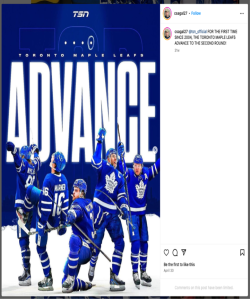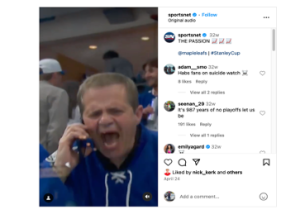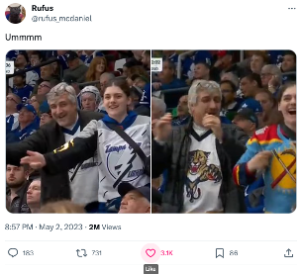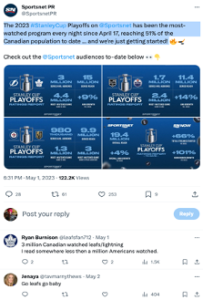31 UNITED BY HOCKEY: EXPLORING THE FANDOM AND PARTICIPATORY CULTURE OF TORONTO MAPLE LEAFS FANS
Bismanbir Singh
INTRODUCTION
Since the late twentieth century, sports fandom has been a popular area of research to study various aspects that are involved in the participatory culture of sports fandom (Wann & James, 2019). Looking at today’s world sports has made the biggest name when we consider doing something in our leisure time. Looking at the statistics that were showed in Professor Derek’s lecture slides sports like NFL and NHL had over 100,000+ viewers when telecasted in 2022 (Derek, 2023, week 10). Different countries have different sports where you see a more active fandom for a sport. For example, when comes to Canadian sports fandom, Hockey is the number 1 sport (Sidani et al, 2021). Researchers have found that many sports consumers have a fandom which is team-centered, and researchers should study that why fans pick up a team and cheer for only that team and maintain fandom for that specific team over the time (Sidani et al, 2021). National Hockey League is one of the most followed Canadian sports with 46% of the population claiming that they follow NHL (Bibby, 2015).
Toronto Maple Leafs is one of the most popular hockey clubs in the Atlantic division of National Hockey League (NHL). With 13 Stanley Cups to their name and their last title win which came in 1967 (NHL, 2023). Since then, the cup has not been into finals and had a 48-year drought between the championships which is currently the longest in the NHL. There is a large number of fans who are still waiting for the most valuable franchise to end their title drought. The studies show that the increase in fandom of a particular team depends on two factors mainly which are the geographic community and playing experience of the team (Mastromartino, 2020). In another study, the result came out that most of the people of Fort Erie supported Toronto maple Leafs because they were closer to the actual geographical location where the club had its home (Sidani et al, 2021). This shows how emotionally a fan is connected to a team which is closer to their home. these are only one type of fans which are termed as local fans, but other type fans are still waiting for the franchise to win the cup. There hopes once again got fire when the team qualified for the playoffs, won the first round and fans of Toronto Maple Leafs got a reason to celebrate after 20 years. But the celebration didn’t last long as they lost in the 5th round of the semi-final’s playoff series.
While looking at these fans and their fandom towards Toronto Maple Leafs, it shaped the research to move further exploring various parts of sports fandom, fan practices, their emotions and effect to the Leafs playoff run of 2023, reaction of anti-fans, how they got into team’s fandom, maintaining fandom, and understanding the fan culture. This paper aims to provide a detailed approach of Toronto Maple leaf’s Fans fandom during their 2023 season run as part of the participatory Culture. I found it convincing to research on because of the reaction of fans and anti-fan’s reaction to the team’s big achievement after almost 20 years and how it was flowing over the media. During the research I came across researchers focus on sport consumer and sport fan in the participatory culture which further led to how media plays an important part in shaping fans behaviour. An attempt was made to move in depth with the above knowledge base to understand the thoughts, feelings, actions, and reactions of sports fans in such a memorable playoff run. As fans of Toronto Maple Leafs were studied to look into different types of fans and how they got into this fandom and why they maintained fandom for years.
METHODOLOGY
This paper will look into several academic and non-academic sources to talk and discuss about the fan’s role in the participatory culture of the team’s playoff run. Although, this paper is not about discussing only fan’s reaction but what different researchers and scholars mentioned about the sports fandom and its related concept. This article also discussed how the role of anti-fans is important in sports fandom and how it might relate to the other types of fandoms. Sport consumer behaviour researchers have conducted a qualitative and interpretive research to dive into the feelings, thoughts and behaviour of sports fans which will be studied in relation to the maple leafs fandom (Sidani et al, 2021). Actual fan reactions on social media have also been discussed to look into different types of sports fans, different dimensions of participation, hashtag public audience engagement in the online platforms. Also, some anti-fan participation has been discussed in the further parts of the essay. Not only this, but some non-academic sources were also researched to know about the fans activity and to identify some course related media which can be discussed into the paper with the help of scholarly sources. Fandom is one of the very big topics to research on and know about different aspects of fandom and have a better understanding of it.
ELEMENTS OF FANDOM
Audience can vary during a sports game, especially in a Toronto Maple Leafs game. In general, consumers are that judge something with economic factors whereas fans have a sense of community and are attached to a specific team and have emotions towards them (Vieracker, 2022). Consumers are a broader term used for the audience, but they also include fans. Also, fans are also consumers of economic products which is hardly mentioned. From a fans perspective during this time period sports fandom was at peak, but it not only included sports fandom but also had elements of consumer fandom.
On May 1, 2023, Toronto’s win over Tampa Bay lightning clinched a total of 4.4 million audience and fans viewing the game over sports net and CBC. As the 2023 playoffs were reached out by 51% Canadian population to set a record of most viewed game. This shows fans involvement in the game as Kelty’s dimension of involvement in goal setting in the participation. Audience participation is all about power (Foster, 2023, week 2). The tweet from SportsNet showed the involvement of fans supporting Toronto Maple leafs in the comment section and resharing the tweets which shows that fans could also be a consumer to a specific post or activity and illustrates fan productivity (Appendix 7). These tweets make a reference to textual productivity where fans retweet and circulate these texts within the fan community. Even the maple leafs social media account plays a role in circulating these texts around fan community and make them aware of what is going on.
FANS ENGAGEMENT ON SOCIAL MEDIA
Fans engage to support the team through various way. Most of the fans try to get into the arena and watch the games live, but it’s not possible for everyone. People set up screens, gather together, look into the scores, and support their team through social media posts (Romney et al., 2021). Social media is a platform which highlights and make fans more enthusiast to engage in the audience community, which contain textual elements layered over digital photography. Not only this, during the research it came out that having narrative images like sharing scores or statistics in the image leads to a more engagement of fans both in number of likes and comments (Romney et al., 2021). The same study showed that Instagram and twitter were the most engaging platforms where the audience numbers were great in terms of variables (Romney et al., 2021). This shows reactionary fandom in terms of engagement in fan activities. A fan posted the Instagram post of Toronto Maple leafs advancing into the finals which expressed his emotions and participation in the audience community (Appendix 1). Another result that comes up is that if athletes were included in the metacommunicative images, the images gained more engagement than a normal post (Romney et al., 2021).
Lastly, how can the scenes outside the Scotiabank Arena in Toronto be missed to study fan engagement. Fans were scene celebrating with joy watching the game on the big screen. People even came to support their team watching the game just outside the actual arena (Toronto Star, 2023). This is a very good example of loyal fans coming to support their team and being loyal to their team. Not only this, but the concept of everyday cosplay can also be seen in the articles post where wore the team’s merchandise to play as a fan of the team (Appendix 2).
ESTABLISHMENT OF FANDOM
There have been many reasons that lead to a fan having an individual connection to a team. Research found that the most important reason to follow a specific team was family influence and attraction to a specific player (Sidani et al, 2021). Not only this, geographical location of a team is also a big factor contributing to the support of the team by a fan. Some researchers have found that a strong influence on team’s preference for children who are getting into sports is mostly from family members (Sidani et al, 2021). Environment of people around a person matters when picking up a team.
Another factor was studied by Sidani in the paper with other researchers that geographic proximity was another factor in supporting the team in the leagues. The study showed that iconic brands like the leafs can easily attract the people from its hometown only and this boosts the franchise in audience engagement and gathering attention of more fans eventually adding them to the fan community and converting them from a non-participatory fan to participatory fan. Research conducted by research co. has found that more than half of the Canadians supported Toronto Maple Leafs in 2023 Stanley cup (Amanat, 2023). The research further showed that the people of Ontario and Atlantic Canada are clearly supported maple leafs as a survey was conducted. This added to another reason creating the hype and more fans backing Maple leafs up. Lastly, the non-participatory fans come into play where 23 per cent of the Canadians said they don’t have a favourite NHL team, which means they like to watch the league from a broader context and enjoy the sport as casual fans. While 20 percent said they don’t know about hockey and just occasionally watch it, which classified them as non-fan because they don’t have interest in any specific sport or entertainment.
MAINTAINING FANDOM
The Toronto maple leafs franchise has arranged several ways through which they can maintain fans supporting them. Researchers have shown results that fans stick to those teams that are usually seen positively and try to gain some social benefits (Sidani et al, 2021). Fans usually support the local team because mostly everyone around is supporting the same team. For example, if fans are supporting Toronto Maple Leafs outside the Scotiabank Arena it would be weird for some other fans to walk through and support their team. These initiatives, fan communities can add to retaining casual fans and making them the regular ones.
EMOTIONS AND AFFECT
During researching about the fan’s activity for this paper, I came across the some of the scenes after Toronto Maple Leafs won the game and how the fans got emotional and exaggerated their affective attachment to the team’s win and how important was it for them breaking the curse. A fan named Billy Kapogiannis got viral as Sportsnet captured his passionate reaction to the teams win (Sportsnet, 2023) (Appendix 3). This passionate reaction towards the team’s win contributed to him being a tribal fan as he has a strong sense of community, loyalty, and an us-versus-them mentality. He shows his us-versus-them mentality when he talks about winning and said, “go get them”, in his interview on BT (Sportsnet, 2023). The phrase he used is an example of textual productivity which was now on every fan tongue who were supporting the maple leafs for their round 2 win. He was invited to the show to talk about his passion and sense of community and his feelings about the win. In the game and in his interview, he was wearing the team’s merchandise showing his support for the team and representing himself as a loyal and tribal fan. (bill’s reaction video).
Another reaction came out with a couple kissing each other right after the game. This was another way how they celebrated the win and got emotional in the post-match celebration as it is a win after 19 years to advance to the round 2 match (McGinn, Narcity Toronto, 2023). This was the feeling expressed what they actually felt and hence is an act of enunciative productivity. Enunciative productivity is understood in cultural context when a felling is created and is spoken and shared in a face-to-face culture (Kusuma, 2023).
Lastly, Toronto’s superfan Kurtis Stevenson gave an interview to fansided in which he stated that he has been collecting from age 15. He stated, “I have 350+ pieces, and every single framed jersey is game worn, and some are even signed. Every other piece of equipment is also game worn.” (Fansided, 2021) (Appendix 4,). This shows the participation of Kurtis and the love and loyalty of a Maple Leaf fan. Fans like him are perfect example of tribal fans and have the sports fandom that these franchises want the fans to build. He is one of the biggest collectors of Leafs Memorabilla.
ANTI-FANS
How can anti-fans be missed during when there is research going on fans, especially of sports. Anti-fans play a very important role in sport fandom, without them sports may not be that much entertaining. Anti-fans refer to a group of people who use sarcasm and criticism of a person, brand, or an activity (Chin et al, 2023). The strategical ratio between a fan and an Anti-fan on a fan page allows one to have a better understanding of the user profile on other social media accounts which helps in providing a more precise capability for social marketing (Chin et al, 2023).
A very popular anti-fan duo of Toronto Maple Leafs was seen during the 2023 Stanley cup. The most interesting thing about them is that they attend the game wearing visitors’ jersey’s and supports them. They even troll people around on camera which is a really strong act of anti-fandom. Trolling is a form of consumer behaviour which involves deliberate, deceptive, and mischievous attempt to provoke reactions from other fans (Golf-papez & Veer, 2022). They have adopted a very unique way of trolling the Toronto maple leafs. As they are doing it for years now, by Wearing opponents’ jersey in every game of maple leafs (Appendix 5). In their interview with offside they said that they want leafs to do well but they want other team to do better than them (Williams, 2023). This type of anti-fandom is known as Politics of against. Politics of against is a kind of fandom where anti-fans engage with a kind of unique perspective with a franchise or celebrity (Foster, 2023). The point of snark is not only to participate in culture of passionate criticism. The duo is passionately involved in supporting the opponents, the reason is just hate for the franchise. Even being the fan of Montreal Canadians, they go to every maple leaf game wearing opponents team jerseys (Williams, 2023). The moment became viral they took a bodyguard with them in the game against Florida Panthers (Williams, 2023). These acts of anti-fandom help the fandom become more interesting to study and fans try to be more supportive to their team. These activities can lead to fan tagonism which is not a healthy thing for the fandom.
CELEBRITY AS FANS
Social media communication by celebrities creates an illusion of relationship which is a two-way communication between the fan-celebrity. This might raise the closeness which might be able to get closer. Many famous celebrities support the Toronto maple leafs. A famous Canadian actor Will Arnett expressed his support by tweeting in support of the team (Appendix 6). Textual productivity describes the more creative objects produced by fans that are circulated more broadly within fan communities (Vimieiro, 2018). Tweets are a perfect example of it. Hence, Will Arnett tweet be a perfect example of textual productivity and the comment section with 158 comments shows the fan celebrity bonds. As he is also a sports fan who can be categorized as loyal fan because of his years of support for the team and in this case the fans might have a Para social relationship with Will Arnett which is called intimate publics. This bond is helpful for the franchise in gaining more fans into the participatory culture of the team.
As everyone knows Drake a famous rapper who is also a loyal fan of Toronto Maple Leafs. Rolling stone covered drake’s Instagram post where he can be seen adding an emotional emoji to his post. The post was a reshare of the footage from Leafs square. These expressive tweets and posts are an excellent example in understanding textual productivity in the participatory culture.
SPORTS CULTURE AS A PARTICIPATORY CULTURE
Participatory Culture is a means of describing how media fandom is operated. A participatory culture is characterized by some low barriers to artistic expression and civic engagement; strong fan support for creating and sharing creations with others; members who believe that their contributions matter; and members who feel some degree of social connection with one another. (Booth, 2018, pg. 13). Above the fans depicted how their creation and sharing of fan support is an important part of participatory culture. Maple Leafs 2023 season playoff run was a very supportive run. As it is characterized by strong support for creating and sharing one’s with others (Jenkins et. al, 2015, Ch 1). Jenkins also focused on other forms of participation and fan activity. one of it is the Fan activism which is a form of civic engagement and political participation that forms of civic engagement and political participation that emerge from within fan culture itself, often in response to the shared interests of fans, often conducted through the infrastructure of existing fan practices and relationships, and often framed through metaphors drawn from popular and participatory culture (Kulinicheva, 2021) (Jenkins et. al, 2015). The gathering of fans in the Leafs Square is a good example explored in this paper as fan activism. As fans gather there every match to form an alliance and watch the match together. This kind of relationship and participatory culture shows how strong feelings fan have towards the fandom of Toronto Maple Leafs.
CONCLUSION
Hockey fandom has explored three different types of fandoms in this paper which are sports, cultural and anti-fandom. This paper has shown how we can see fan culture and Sports fandom in participatory culture. Also, this explored some key elements of participatory audience as fans and as consumers. Fans were categorized in different categories to know better about how they behave and the level of participation they show towards their franchise. Using the fan approaches to study is an important to understand the fandom and why people are so engaged in the participatory culture and where they got involved into this fandom from. I argued how affect plays an important in fandom of sports and get fans involved in the fan communities. Their emotions play a significant role in relating interests with other fans and fan communities. These fans also involve celebrities who support the teams and become an object fan who are fans of Toronto Maple Leafs are a very good examples of loyal fan, participatory culture, fan communities, and how fans of sports fandom participate. I argued that this approach of fandom is about fan communities, emotions as well as the dimension of participation the fans depict. Furthermore, the research on Maple Leafs fan should focus on how political fandom affect sports fandom and the participatory dimensions of Toronto maple leafs fan communities in different parts or countries around the world. I hope this study will be helpful in examining the Sports fandom with relation to other kind of fandoms around it and how different objects can be helpful in studying fandom.
APPENDIX
(Appendix 1, Fan engaging on social media)

(Appendix 2, Celebration at Leafs Square)

(Appendix 3, Billy’s reaction to win)

(Appendix 4, Super fan Kurtis with his man cave collection)
(Appendix 5, The Anti fan duo)

(Appendix 6, Will Arnett’s tweet)

(Appendix 7, Tweet of viewership)

REFERENCES
- Amanat, H. (2023, May 12).Over half of Canadian hockey fans support the Toronto Maple Leafs in Stanley Cup playoffs: poll. CTVNews.
- Bibby, R. W. (2015). The 2015 CANAM sports survey. http://www.reginaldbibby.com/images/ 2015_CanAm_Sports_Interest_Survey_FINDINGS_OVERVIEW_July_15_2015.pdf
- Booth, P. (Ed.). (2018).A companion to media fandom and fan studies. John Wiley & Sons.
- BT Studios. (2023, April 26).Viral Maple Leafs fan Billy Kapogiannis talks about his star moment on BT. Www.sportsnet.ca.
- Chan, T. (2023, April 30).Drake, Will Arnett Celebrate Toronto Maple Leafs’ (Long-Awaited) Postseason Triumph. Rolling Stone.
- Chin, C.-Y., & Huang, W.-Y. (2023). Discovering fans and anti-fans among social media users based on their emotional reactions and comments.Journal of Information Science, 16555152311622-.
- Csagal27 (2023, April 30). @tsn_officialFOR THE FIRST TIME SINCE 2004, THE TORONTO MAPLE LEAFS ADVANCE TO THE SECOND ROUND!. Instagram. 2023 December 3rd.
- Foster, D. (2023). Audience Studies: Sports Fandom.Week10
- Golf-Papez, M., & Veer, E. (2022). Feeding the Trolling: Understanding and Mitigating Online Trolling Behavior as an Unintended Consequence.Journal of Interactive Marketing, 57(1), 90–114.
- Jenkins, Henry, Mizuko Ito, and danah boyd. 2015.Participatory Culture in a Networked Era: A Conversation on Youth, Learning, Commerce, and Politics. Cambridge: Polity. Kindle.
- Kulinicheva, Ekaterina. 2021. “Sneakerheads as Fans and Sneaker Fandom as Participatory Culture.”Transformative Works and Cultures, no. 36.
- Kusuma, R.S., Munasah. S.A. (2023). HOW TO BECOME A PRODUCTIVE FAN? THE EXISTENCE OF FAN TALKS AS FANDOM PRODUCTIVITY. (n.d.).Profetik.
- Mastromartino, B., Qian, T. Y., Wang, J. J., & Zhang, J. J. (2020). Developing a Fanbase in Niche Sport Markets: An Examination of NHL Fandom and Social Sustainability in the Sunbelt.Sustainability (Basel, Switzerland), 12(3), 1115-.
- McGinn, S. (2023, April 25).Toronto Maple Leafs Fans Got So Emotional After Overtime Win & Reactions Have Gone Viral – Narcity. Www.narcity.com.
- Meier-Vieracker, S. (2022). Between consumers and fans: Writing fan reports as a multifunctional evaluation practice.Journal of Cultural Analytics, 7(2).
- N.D. (2023). Toronto Maple Leafs.
- N.d. (@SportsnetPR) 2023. The 2023 #StanleyCup Playoffs on @Sportsnet has been the most-watched program every night since April 17, reaching 51% of the Canadian population to date … and we’re just getting started!. Tweet 1.
- Reporter, B. M. S. (2023, April 29).Hockey fans celebrate victory in maple leaf square. Toronto Star.
- Ridgewell, J. (2021, November 28).Exclusive interview with toronto maple leafs super fan kurtis stevenson. Editor in Leaf.
- Romney, M., & Johnson, R. G. (2020). Show me a story: narrative, image, and audience engagement on sports network Instagram accounts.Information, Communication & Society, 23(1), 94–109.
- Rufus (2023, May 2). UMMM. Twitter. (2023, December 3rd).
- Sidani, E., Hyatt, C., & Kerwin, S. (2021). Hockey fandom on the border: an interpretive study of Toronto Maple Leafs and Buffalo Sabres fans in Fort Erie, Ontario, Canada.Leisure = Loisir, 45(2), 269–299.
- Sportsnet (2023, April,24). THE PASSION. Instagram. (2023, December 3rd).
- Vimieiro, A. C. (2018). The digital productivity of football supporters: Formats, motivations and styles.Convergence (London, England), 24(4), 374–390.
- Wann, D. L., & James, J. D. (2019). Sport fans: The psychology and social impact of fandom. Routledge.
- Williams, R. (2023, May 4).Viral anti-Leafs fans are bringing a bodyguard with them to tonight’s game | Offside. Dailyhive.com. https://dailyhive.com/vancouver/anti-leafs-fans-game-2-playoffs-bodyguard

